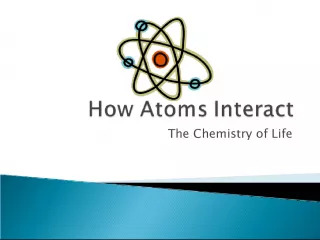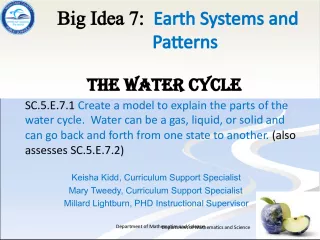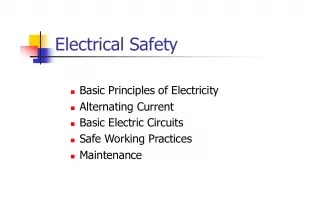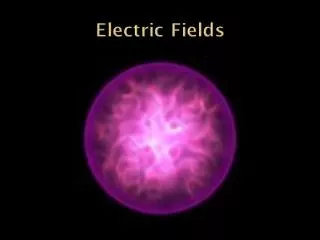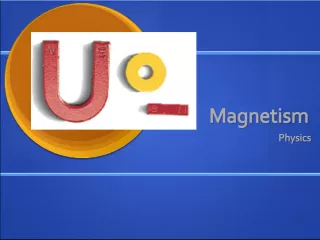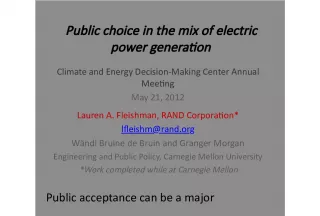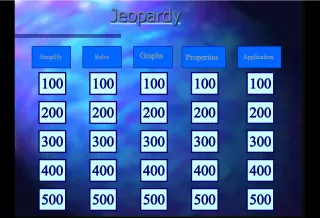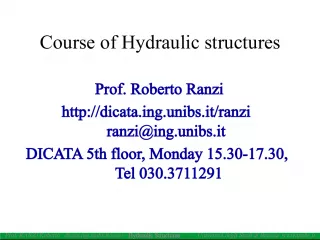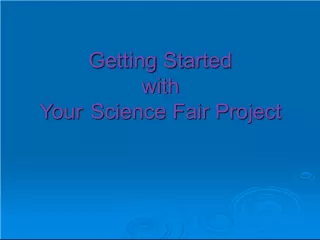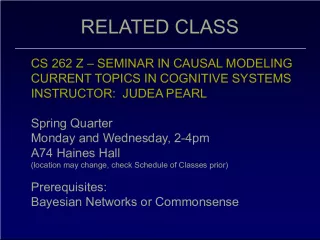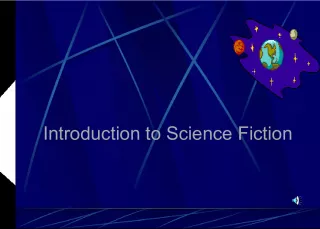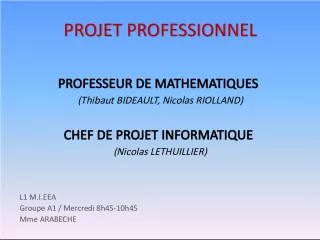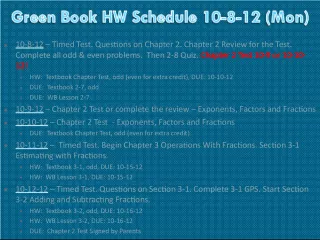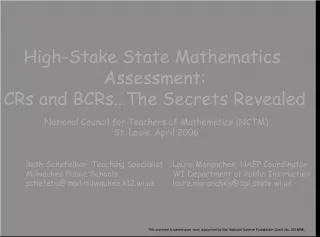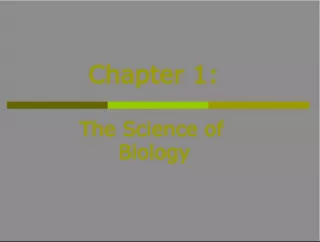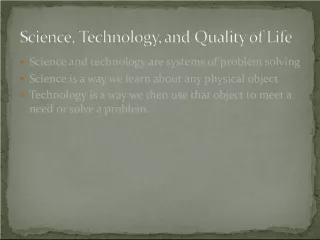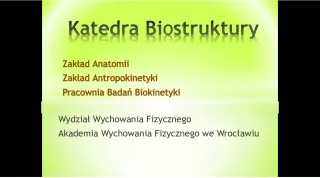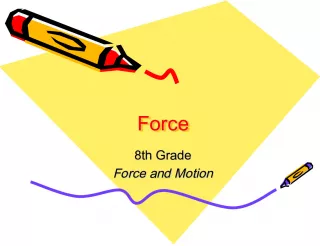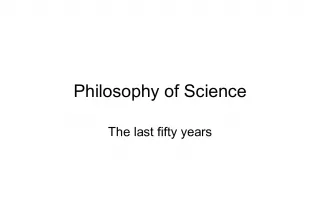Department of Mathematics and Science: Static Electricity Essential Lab 6
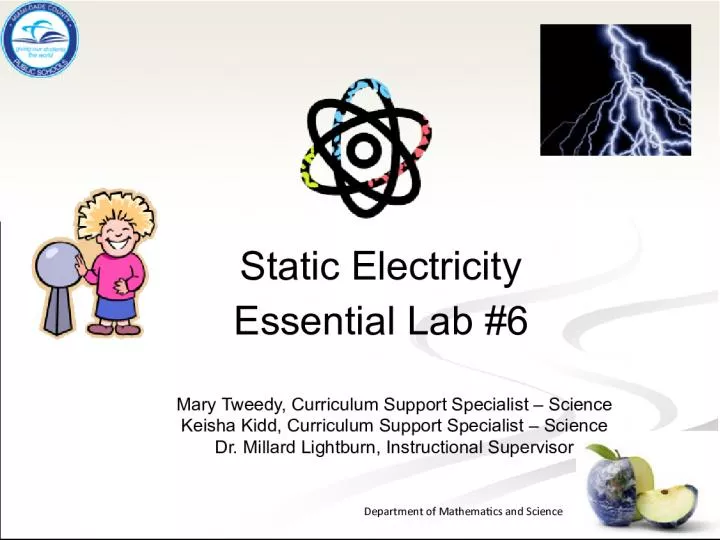

This lab, developed by Mary Tweedy and Keisha Kidd, the Curriculum Support Specialists for Science, and overseen by Dr. Millard Lightburn, the Instruction
- Uploaded on | 5 Views
-
 aidancooper
aidancooper
About Department of Mathematics and Science: Static Electricity Essential Lab 6
PowerPoint presentation about 'Department of Mathematics and Science: Static Electricity Essential Lab 6'. This presentation describes the topic on This lab, developed by Mary Tweedy and Keisha Kidd, the Curriculum Support Specialists for Science, and overseen by Dr. Millard Lightburn, the Instruction. The key topics included in this slideshow are . Download this presentation absolutely free.
Presentation Transcript
Slide1Department of Mathematics and Science Static Electricity Essential Lab #6 Mary Tweedy, Curriculum Support Specialist – Science Keisha Kidd, Curriculum Support Specialist – Science Dr. Millard Lightburn, Instructional Supervisor
Slide2Department of Mathematics and ScienceWhat Do You Know About Atoms ? • All matter is made up of tiny particles called atoms. • Atoms contain protons, electrons and neutrons. • Protons have a positive charge, electrons a negative charge, and neutrons a neutral charge. • There are 115 different atoms. • All matter is made up of different combinations of these atoms.
Slide3Department of Mathematics and ScienceAtoms Let’s Model the Parts of an Atom • Need : 8 Volunteers (2 neutrons, 2 electrons, 2 protons, 1 nucleus, and 1 atom) Here’s what to do: • Atom” person holds up the sign and stands near the outside of the circles. • The “Nucleus” stands inside the circle and hold his/her sign up • The 2 “Protons” go inside the center of the circle. • The 2 “Neutrons” go inside the circle • One “Electron” stands on each of the outer circles • “Both Electrons” walk quickly around their orbit All: Draw a diagram of the model we just made in your journal.
Slide4Department of Mathematics and ScienceAll matter is made up of tiny particles called atoms. What are an atom’s 3 basic parts? 1. Neutrons 2. Protons 3. Electrons What are their electrical charges? a. Neutral b. Positive c. Negative
Slide5Department of Mathematics and ScienceWhat do Atoms have to do with Static Electricity? Check this out: http://www.teachersdomain.org/asset/phy03_vi d_zsnap/ Discovery Video: Static Electricity
Slide6Department of Mathematics and ScienceNow it’s Your Turn to Explore Essential Lab #6 Static Electricity Key Question: How does static electricity cause objects to attract or repel? Rotate through the 4 stations, follow the directions, and record your data in the chart.
Slide7Department of Mathematics and ScienceKey Question: How does static electricity cause objects to attract or repel? Explain/Evaluate a. How does what you observed at Station 1 provide evidence to answer your key question? b. How does what you observed at Station 2 provide evidence to answer your key question? c. How does what you observed at Station 3 provide evidence to answer your key question? d. How does what you observed at Station 4 provide evidence to answer your key question?
Slide8Department of Mathematics and Science Let’s Take Another Look The protons’ positive charges and their electrons’ negative charges are typically electrically balanced in an atom. Rubbing the balloon on one’s hair (friction) causes it to gain electrons and become negatively charged. This makes your hair stand on end by giving them all the same charge, making them repel one another. - + - + - + - +
Slide9Department of Mathematics and ScienceTry This: Discovery Exploration: Static Electricity Rubbing the balloon on your hair, gives it a surplus of electrons. A wall will have an opposite charge, causing them to attract one another and allowing the balloon to stick to the wall.
Slide10Department of Mathematics and ScienceWhat Do You Know Now? • What is static electricity? • When does a static charge build up on an object? • What happens when a static charge builds up on an object? • What is an example from nature of static electricity?
Slide11Department of Mathematics and ScienceWhat is Static Electricity? • Static electricity is a buildup of electrical charge in an object. • Friction can cause a static charge buildup. • Static charge causes objects to attract or repel. • Static charge can be released as a brief burst of electrical energy, sometimes visible as a spark, and felt as a shock. Discovery Reading Passage: Don’t Move
Slide12Department of Mathematics and ScienceWhen Does a Static Charge Build Up on an Object? There are forces that can change an object’s electrical charge. One such force is friction . Friction is produced by rubbing two objects together. For example, when you walk across the floor, your shoes rub against the carpet. This creates friction. The friction causes electrons to flow from the carpet to your body. Both your body and the carpet become electrically charged.
Slide13Department of Mathematics and ScienceWhat causes static electricity? • http://www.ehow.com/video_4756347_what- causes-static-electricity.html
Slide14Department of Mathematics and ScienceWhat Happens When a Static Charge Builds Up on an Object? An electrically charged object can exert a force on other objects. A charged object will pull on uncharged objects and on objects that have an opposite charge. A charged object will push away another charged object that has the same charge. Static charge can also jump from a charged object to another object. The shock you might feel after rubbing your feet on the carpet is an example of this jump of electrical charge.
Slide15Department of Mathematics and ScienceWhat Is an Example from Nature? Lightning is the release of a very large static charge. Friction causes static electricity to build up in the clouds. Sometimes, electrons jump from cloud to cloud, releasing a very large static charge. The sky lights up, and we see a flash of lightning. Sometimes electrons jump from the cloud to the ground. This creates another flash of lightning.
Slide16Department of Mathematics and ScienceRESOURCES Atoms: Protons, Neutron and Electrons • Study Jams - Atoms: Protons, Neutron and Electrons http://studyjams.scholastic.com/studyjams/jams/science/matter/atoms.htm • http://www.teachersdomain.org/asset/phy03_vid_zsnap/ • Bill Nye http://www.youtube.com/watch?v=Z-77IzaXGcg&safe=active • http://www.loc.gov/rr/scitech/mysteries/static.html • http://www.ehow.com/how-does_4564266_static-electricity-work.html • http://sciencespot.net/Media/atomsfam.pdf • http://sciencespot.net/Media/atomsfam.pdf (Atom’s Family) (Atom’s Family) • Study Jams- Electricity: http://studyjams.scholastic.com/studyjams/jams/science/energy-light- sound/electricity.htm • Study Jams- Electricity: http://studyjams.scholastic.com/studyjams/jams/science/energy-light- sound/electricity.htm • www.Chem4kids.com • www.Chem4kids.com
